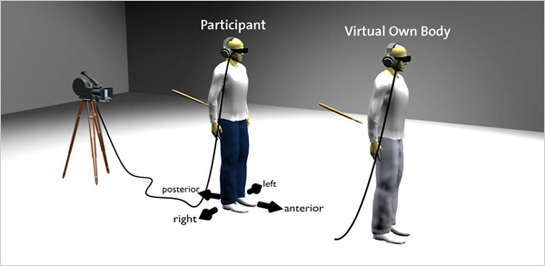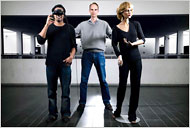Studies Report Inducing Out-of-Body Experience
Using virtual-reality goggles, a camera and a stick, scientists have induced out-of-body experiences "the sensation of drifting outside of one's own body" in ordinary, healthy people, according to studies being published today in the journal Science.
When people gazed at an illusory image of themselves through the goggles and were prodded in just the right way with the stick, they felt as if they had left their bodies.

The research reveals that "the sense of having a body, of being in a bodily self," is actually constructed from multiple sensory streams, said one expert on body and mind, Dr. Matthew M. Botvinick, an assistant professor of neuroscience at Princeton University.
Usually these sensory streams, which include vision, touch, balance and the sense of where one’s body is positioned in space, work together seamlessly, Dr. Botvinick said. But when the information coming from the sensory sources does not match up, the sense of being embodied as a whole comes apart.
The brain, which abhors ambiguity, then forces a decision that can, as the new experiments show, involve the sense of being in a different body.
The research provides a physical explanation for phenomena usually ascribed to otherworldly influences, said Peter Brugger, a neurologist at University Hospital in Zurich, who, like Dr. Botvinick, had no role in the experiments. In what is popularly referred to as near-death experience, people who have been in the throes of severe and sudden injury or illness often report the sensation of floating over their body, looking down, hearing what is said and then, just as suddenly, finding themselves back inside their body.
Out-of-body experiences have also been reported to occur during sleep paralysis, the exertion of extreme sports and intense meditation practices.

The new research is a first step in figuring out exactly how the brain creates this sensation, Dr. Brugger said.
The out-of-body experiments were conducted by two research groups using slightly different methods intended to expand the so-called rubber hand illusion.
In that illusion, people hide one hand in their lap and look at a rubber hand set on a table in front of them. As a researcher strokes the real hand and the rubber hand simultaneously with a stick, people have the vivid sense that the rubber hand is their own. When the rubber hand is whacked with a hammer, they wince and sometimes cry out.
The illusion shows that body parts can be “separated” from the whole body by manipulating a mismatch between touch and vision. That is, when a person’s brain sees the fake hand being stroked and feels the same sensation, the sense of being touched is misattributed to the fake.
The new experiments were designed to create a whole-body illusion with similar manipulations.
In Switzerland, Dr. Olaf Blanke, a neuroscientist at the École Polytechnique Fédérale in Lausanne, asked people to don virtual-reality goggles while standing in an empty room. A camera projected an image of each person taken from the back and displayed that image as if it were six feet in front of the subject, who thus saw an illusory image of himself.
Then Dr. Blanke stroked each person’s back for one minute with a stick while simultaneously projecting the image of the stick onto the illusory body.
When the strokes were synchronous, people reported the sensation of being momentarily within the illusory body. When the strokes were not synchronous, the illusion did not occur.
In another variation, Dr. Blanke projected a "rubber body" — a cheap mannequin bought on eBay and dressed in the same clothes as the subject — into the virtual-reality goggles. With synchronous strokes of the stick, people’s sense of self drifted into the mannequin.
A separate set of experiments was carried out by Henrik Ehrsson, an assistant professor of neuroscience at the Karolinska Institute in Stockholm.
Last year, when Dr. Ehrsson was "a bored medical student at University College London," he wondered, he said, "what would happen if you 'took' your eyes and moved them to a different part of a room."
"Would you see yourself where your eyes were placed?" he said. "Or from where your body was placed?"
To find out, he asked people to sit in a chair and wear goggles connected to two video cameras placed six feet behind them. The left camera projected to the left eye, the right camera to the right eye. As a result, people saw their own backs from the perspective of a virtual person sitting behind them.
Using two sticks, Dr. Ehrsson stroked each person's chest for two minutes with one stick while moving the second stick just under the camera lenses, as if it were touching the virtual body.
Again, when the stroking was synchronous, people reported the sense of being outside their own bodies, in this case looking at themselves from a distance where their "eyes" were situated.
Then Dr. Ehrsson grabbed a hammer. While people were experiencing the illusion, he pretended to smash the virtual body by waving the hammer just below the cameras. Immediately, the subjects registered a threat response as measured by sensors on their skin. They sweated, and their pulses raced. They also reacted emotionally, as if they were watching themselves get hurt.
Participants in the experiments conducted by Dr. Blanke and Dr. Ehrsson reported having felt a sense of drifting out of their bodies, but not a strong sense of floating or rotating as is common in full-blown out-of-body experiences, the researchers said.
The next set of experiments, they said, will involve decoupling not just touch and vision but other aspects of sensory embodiment, including the sense of balance and the body's position in space.